The newest comparison is between two different air purifiers, the Blueair 411 and the Coway AP-1512HH. Even though this battle may be unfair, I decided to write this article due to many inquiries about comparing Blueair and Coway.
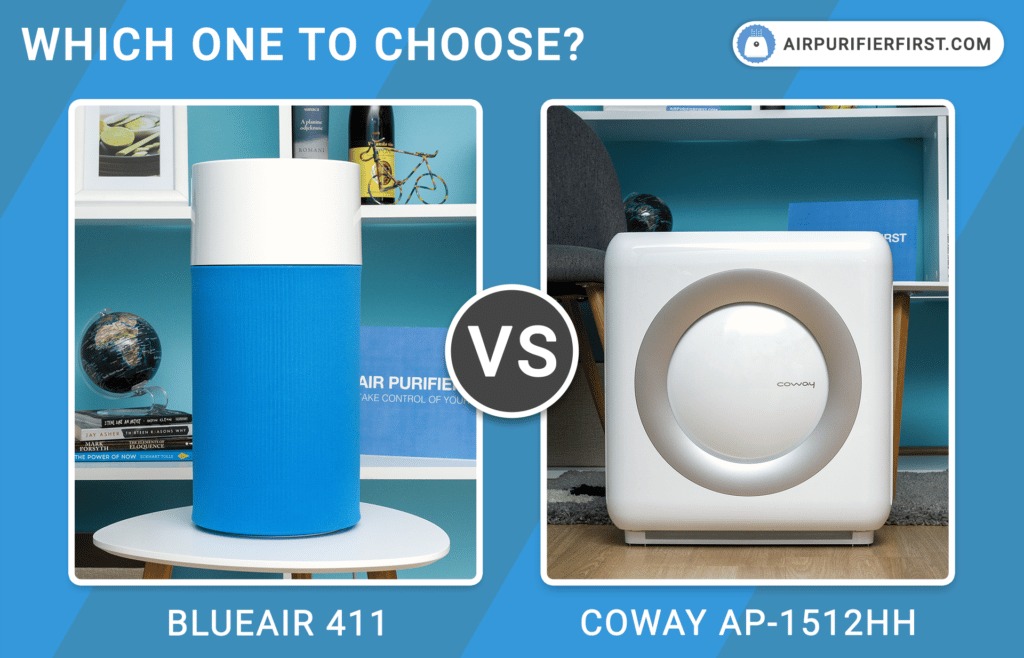
Table of Contents
Coway AP-1512HH covers up to 361 sq. ft., while the Blueair 411 covers up to 161 sq. ft. The most significant difference between these two devices, in addition to room coverage, is within their features. The Coway has a lot of built-in advanced options, of which I like the air quality sensor, ECO mode, and auto mode. On the other hand, the Blueair 411 is a minimalist air purifier without any advanced features.
Blueair stands out for its washable pre-filter, minimalism, and ease of use, while immense high-quality filters and high reliability characterize the Coway.
In the following, I will compare these two devices in detail, show the results with all the tests done, and compare their specifications. Based on all mentioned, I will determine the winner and a better choice for buying.
Blueair Vs Coway Specifications
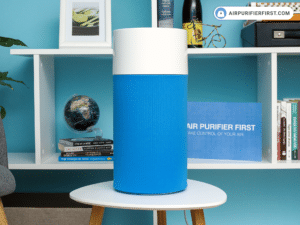 |
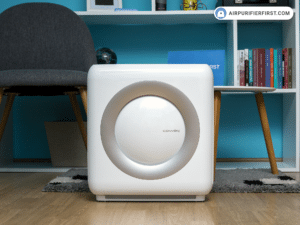 |
|
| Manufacturer | Blueair | Coway |
| Model | 411 | AP-1512HH |
| Dimensions | 16.7 x 8 x 8 inches | 16.81 x 9.65 x 18.30 inches |
| Room Coverage (4.8 ACH) | 161 sq. ft. | 361 sq. ft. |
| Performance Ratings | ||
| Filtration Technology | Washable Pre-filter, Particle Filter, and Carbon Filter | Pre-filter, Deodorization Filter, True HEPA Filter, and Ionizer |
| Filter Replacement Indicator | Yes | Yes |
| Filter Longevity | 6-8 months | up to 12 months |
| Power | 10W | 77W |
| Operating Costs Ratings | ||
| Fan Speeds | 3 – Speed 1, Speed 2, and Speed 3 | 3 – Speed 1, Speed 2, and Speed 3 |
| Air Quality Sensor | No | Yes |
| Air Quality Indicator | No | Yes |
| Auto Mode | No | Yes |
| ECO Mode | No | Yes |
| Display Off | No | No |
| Ionizer | No | Yes |
| Noise Levels | 40.6 – 67.5 dBA | 41.4 – 63.5 dBA |
| Noise Ratings | ||
| Warranty | 2-year | 3-year |
| In-Depth Review | Blueair 411 | Coway AP-1512HH |
| Price | Check Price on Amazon | Check Price on Amazon |
Features Overview
Air Quality Sensor and Air Quality Indicator
The Blueair 411 is missing this feature, but Coway doesn’t quite the opposite. The Air quality sensor that Coway AP-1512HH has is super sensitive in a way that it can be adjusted to three levels: sensitive, standard and insensitive. Along with the Air quality indicator, located next to the filter reset indicator, the air quality sensor will monitor the real-time situation and update the user of it. Depending on the air quality, the Indicator will be colored blue, orange, or red.
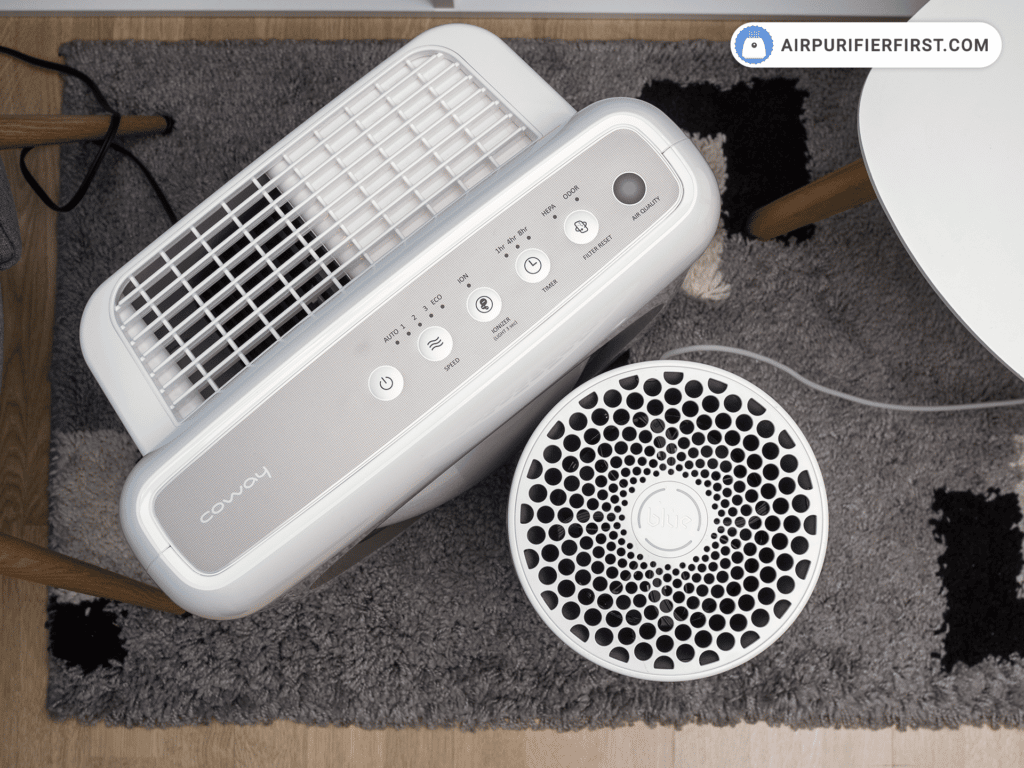
A tip for you: the air quality sensor can be cleaned manually. Just remove the sensor cover and clean it gently with a q tip.
More on how to adjust the air quality sensor, you can find in Coway AP-1512HH stand-alone review.
Auto Mode
Somehow we all like that Auto setting on each device we own. It’s one of those features that keep things working even when we are too tired or busy to work by ourselves. The Auto mode feature is only available at Coway AP-1512HH because it relies on data collected by the Air quality sensor. Based on that data, the Auto mode sets the appropriate speed level.
ECO Mode
Like the Auto mode, the ECO mode is only available within Coway AP-1512HH. The ECO mode is a kind of advanced Auto mode that saves you electricity, money, filters… You see, the ECO mode also runs automatically by constantly collecting data from the air quality sensor. If the collected data are satisfying for the last 30 minutes, the air purifier will remain in standby mode. But, if, for some reason, the air gets contaminated, the ECO mode wakes up the air purifier and keeps it operating until the air is clear again. Great, isn’t it?
Timer
One of the ways you can control your air purifier is to set the operating time interval. The Coway AP1512-HH air purifier comes with a built-in Timer, which means you can choose between 1h, 4h, or 8h time intervals. Once the time runs out, the air purifier stops working.
Unlike Coway, Blueair doesn’t come with this option by default. However, Blueair411 is smart-plug compatible, which means you can use it almost like a Timer. You can set the time interval in which the appliance will be turned ON or OFF. Use it, and use it wisely.
Ionizer
This feature is considered Coway’s fourth stage of filtration and one of the most competitive advantages. If you want it to work, you’ll have to turn it ON by yourself. Once you do that, the whole ionization process begins, which results in trapping all the pollutants and allergens such as dust, pollen, pet dander, or cigarette smoke. Collecting all of these is just a piece of cake for Coway AP1512-HH.
If you want to know more about the ionizing procedure, you can check out the Coway AP1512-HH separate review.
Too bad that Blueair 411 doesn’t have this feature built-in.
Filter Reset Indicator
One of the greatest advantages that a filter reset indicator offers is worry-less air purifier maintenance. All you have to do is wait for the red light, and replace the filter. Keep this in mind, filter wornness depends on how often you use the air purifier.
While Coway AP-1512HH needs an annual filter replacement, Blueair 411 will need you to do it more often. Mainly between 6-8 months. Anyway, if you notice your air purifier is not like it used to be, it just may be missing a cleaning or a filter replacement.
Airflow
Like many other cylindrical-shaped air purifiers, the Blueair 411 also has air inlets spread all over the unit’s body. That way, you get a 360-degree suction, after which the air gets filtered and spread throughout the holes on the upper part of the appliance.
At the same time, Coway has its vents positioned frontally, on both sides, and at the bottom. The air runs through filters and the Ionizer if it’s ON. Later on, the air is released upwards, through the vents.
Warranty
The Blueair company will have you covered with a one-year warranty if you decide to buy the Blueair 411 model. However, it will also encourage you to register on their website, if you wish to have an extra year of warranty.
On the other hand, Coway gives a generous 3-year manufacturer warranty coverage. Can’t do any harm to have that extra year of protection.
Filtration Technology
Both Blueair 411 and Coway AP-1512HH have a 3-stage filtration, with an optional fourth stage that Coway can use to upgrade its functionality.
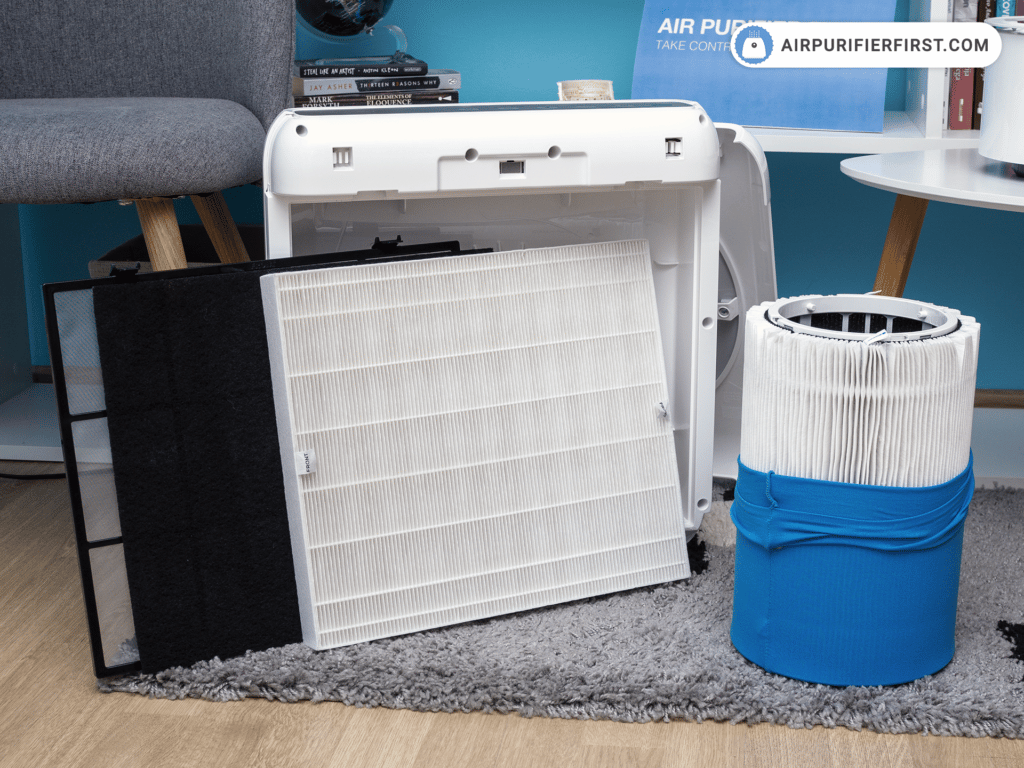
You might say that Coway has that standard 3-in-1 filter: pre-filter, carbon filter, and a True HEPA filter. I say might because as you can see the True HEPA filter comes as the third in a row. Nevertheless, their functions are what make this air purifier your possibly next best friend.
Pre-filter is there to collect nasty particles like dust, animal fur, or hair. The good thing is it is washable so feel free to clean it every 2-4 weeks if you want your Coway air purifier to work smoothly. The carbon filter that comes in the second stage is not pellet-based as you’d probably expect, but a fibrous filter covered with carbon. Its main purpose is to clean the room from harmful gases, and all sorts of odors, pleasant and less pleasant, but also VOCs. The True HEPA filter is an awesome filter that captures 99.97% of airborne allergens, including pollen, mold spores, pet dander, microbes, etc.
What Blueair 411 shares with Coway are a washable pre-filter. Still, this pre-filter is pretty unique. As you can see in the picture, the pre-filter is a fabric that you can put on an air purifier and take it off when you need to clean it. You can dust it or wash it. Suit yourself. Fun fact: you can find this fabric pre-filter available in various colors.
As for the second and third filtration stages, they come as 2-in-1 filters. Those are Particle and Carbon filters. The particle filter is good, but, to be as good as True HEPA, it needs to be certified and collect more than just 99% of airborne particles. The Carbon filter is also fibrous and not a pellet-based filter. Still, it is good enough to reduce the unpleasant odors from your working or home space.
How to replace filters on both devices?
If an air purifier has a filter reset indicator, you should know you are one step ahead. This indicator will save you time and energy, by keeping track and informing you when it’s time to do the replacement.
There is only one slight difference between Coway AP-1512HH and Blueair 411. The Coway has two separate indicators, one for the True HEPA filter and one for the Carbon filter. The first indicator should be replaced once a year, but the other usually wears out after 6 months.
The Blueair has only one indicator which will light up in about 6-8 months.
Still, if you notice that filters are too dirty to be waiting for the expiry date, you should replace them sooner.
Noise Test
Regarding noise levels, this may be the easiest way to compare Blueair 411 and Coway AP-1512HH, because both have 3-speed levels. This is where things become tricky.
While Coway is pretty silent while on Speed 1, Blueair is almost unnoticeable. It runs smoothly, perfect for a good night’s sleep. Coway also has that smooth operating mode while on first speed.
However, things start to change with speeding up. Coway gets faster and louder, but not too loud. On the other hand, Blueair becomes way too loud for my taste. Then again, there’s the third speed that turns these air purifiers into very loud machines. Coway can reach up to 63.5 dBA, while Blueair hits the sky with 67.5 dBA.
| Product | Noise Range (dBA) |
|---|---|
| Coway AP-1512HH | 41.4 – 63.5 dBA |
| Blueair 411 | 40.6 – 67.5 dBA |
Now, I can handle Coway’s speeding up and noise upgrading, because this device has various modes how to turn it into a perfect home appliance. The Blueair, on the other hand, has to do something about that noise.
I know the airflow is at its highest while on maximum speed, but still. If the noise was determining factor, I must say, I’d rather pick Coway instead of Blueair.
Performance Tests
I have said it before, and I’ll say it again. Blueair 411 is designed for a 161 sq. ft. room coverage, while Coway can cover much more, up to 361 sq. ft.
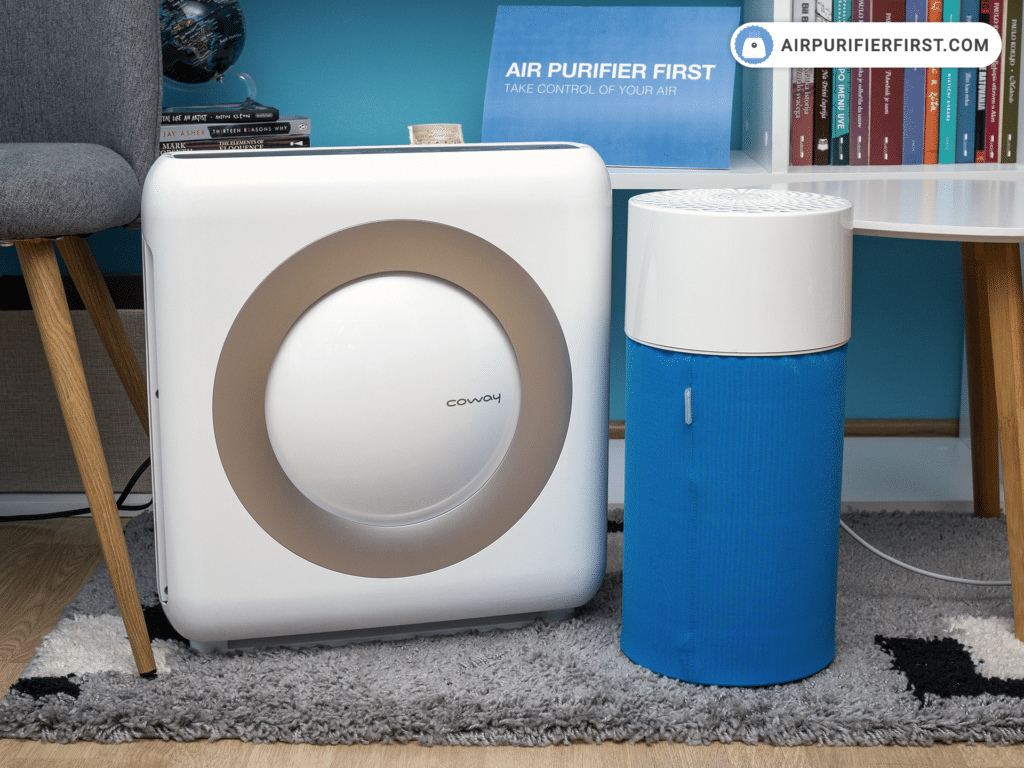
For this reason, I wanted to take several different tests. Each test was conducted separately, with appliances being left constantly running for 60 minutes while being set to the maximum speed.
194 sq. ft Room Test
This test was made only with Blueair 411, to see how well it will handle rooms that oversize the initial 161 sq. ft. I have to admit, I was pleasantly surprised. The air purifier managed to improve the air quality by 95%, which is an outstanding result for such a device.
320 sq. ft. Room Tests
As you can see, this square footage is double the size that Blueair can cover, according to a producer. However, this little fella did an amazing job with 90% cleaner air. Now, that’s what I call a success!
The other air purifier, the Coway, also did an amazing job with its 96% air improvement rate. Need I mention how much noise I have suffered during these tests? Just joking.
320 sq. ft. Room
* Data measuring time is 60 minutes.
Yet, there is another test I wanted to do with Coway, and it had to be while on Auto mode. Also, I have set the air quality sensor to the standard mode, to make the results relevant. And they were. I find that 90% air improvement is more than satisfying.
Now, both air purifiers gave their best shot, and I was surprised by the results I came up with. Somehow, I will rule out in favor of Coway AP-1512HH, because it is more powerful.
Operation Cost
Here is data to begin with. While Coway AP-1512HH has 77W of motor power, Blueair 411 has only 10 Watts to compete with.
Regarding the initial product price and the filter replacement cost, Blueair seems to be a more affordable product than Coway.
Even the fact that you will have to replace filters approximately twice a year, still, the cost is below Coway’s. To be sure of my decision, I have to consider all the factors related. So, if you left both air purifiers constantly working at top speed, for a whole month, by the end of this period Blueair would cost you only 0.66$. Coway, on the other hand, would cost you 6$, which is a significant difference.
| Product | Wattage Range (W) |
|---|---|
| Coway AP-1512HH | 0.2 – 69.1W |
| Blueair 411 | 0.3 – 7.6W |
And just like that, Blueair gets to be the best-buy option.
Which One Does It Better?
After an in-depth analysis, I chose the Coway AP-1512HH as a better choice and a far better option than the Blueair 411.
There are many reasons such as the True HEPA filter, reliable air quality sensor, ECO mode, ionizer, as well as long-lasting filters. In addition, Coway covers much larger rooms than Blueair.
The Blueair 411 is also an excellent air purifier, and I would recommend it if you need a device for a smaller room where Coway would be too strong.
If you have any questions about these two devices, leave a comment in the comments box below.
Leave a Reply